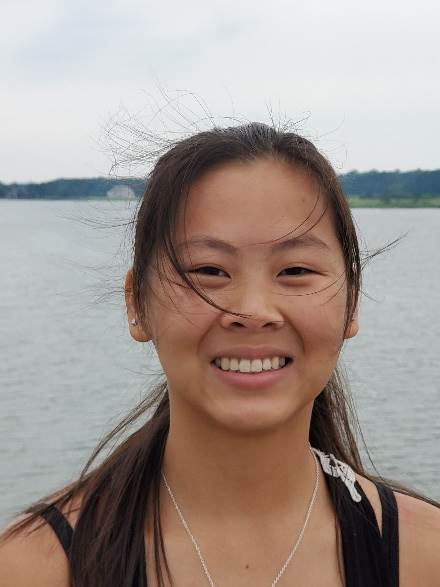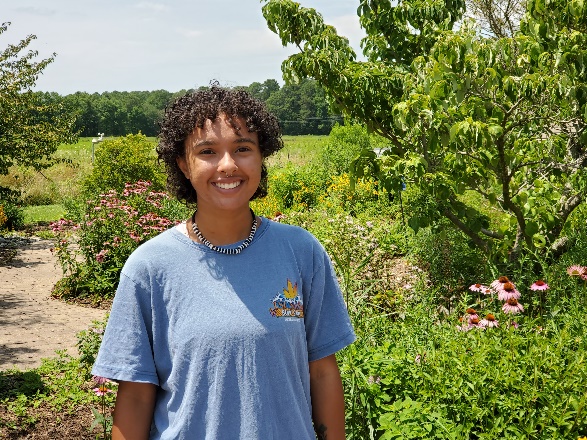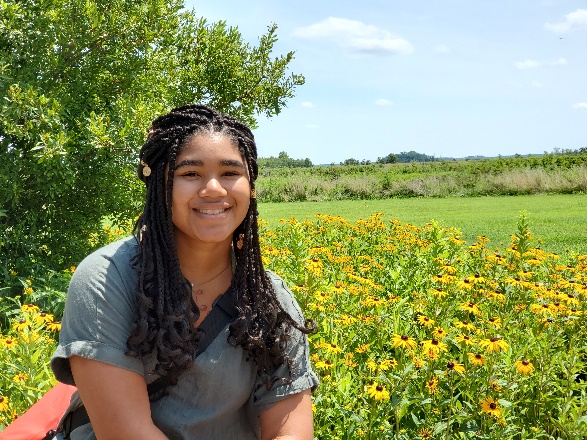2021 Student Participants

Carley Bishop, Centre College of Kentucky
Faculty Mentor: Drs. Ligia DaSilva, Salina Parveen, and Paulinus Chigbu
The Prevalence of Fecal Indicator Bacteria within the Maryland Coastal Bays
Fecal Indicator Bacteria (FIB) are used to assess the presence of pathogenic bacteria in aquatic environments. Water samples were collected from 12 sites (Fig. 1) in the Maryland Coastal Bays (MCBs) and analyzed for the presence of various FIB using MPN and plate count methods in order to evaluate human impacts. Heterotrophic bacteria count was highest within site 5 at 4470 CFU/mL. Fecal coliform (34 MPN/mL) and Enterococci (28 CFU/100mL) counts were highest at site 6. Results showed no significant correlation between human population density and fecal contamination (p>0.05). The observed FIB counts in June and July are below the EPA standards for recreational waters. Further studies are needed to obtain data to describe the seasonal variation of FIB counts in the Bays.

Calli Cunningham, California State University Channel Islands
Faculty Mentor: Dr. Kausiksankar Das
Solar Driven Interfacial Evaporation
Water scarcity has been a global issue for a long time that has been exacerbated and intensified due to climate change and the unpredictability of changing weather patterns. These global changes are not only affecting certain areas but cause a domino effect that extends across the globe affecting everyone. In order to combat global water scarcities and create clean drinking water, solar driven interfacial evaporation has been successful, however unsustainable and expensive. In order to create an efficient, biodegradable, sustainable and cost-effective mechanism the use of carbonized paper substrate has achieved a ~85% increase in thermal efficiency.

Lauryn Howell, Stevenson University
Faculty Mentor: Dr. Andrés G. Morales-Núñez
Graduate Student Mentor: Kayle Krieg
Abundance and Distribution of Benthic Macroinvertebrates Relative to Abiotic Factors, Chincoteague Bay, Maryland
The main objectives of this study were to characterize the abundance and distribution of several marine macroinvertebrates in Chincoteague Bay and establish correlation between biotic and abiotic factors. Samples were collected from five sites in Chincoteague Bay, Maryland. Organisms were counted and sorted, and sediment composition was characterized. Results showed main groups of interest to be Amphipoda, Polychaeta, Cumacea, Nematoda, and Gastropoda. Total abundance was found to be 3,715 organisms. Future studies should focus on elucidating the reasons for the disparity between data from month to month.

Kiah Matthews, Nova Southeastern University
Faculty Mentor: Drs. Ali Ishaque and Paulinus Chigbu
Graduate student Mentor: Chelsea Richardson
Tracing Food Web Dynamics Using Fatty Acid Analysis and Mercury Concentrations in Blue Crabs
It is important to study environmental and man-made factors impacting food web structures. Blue Crab (Callinectes sapidus) plays an important role in the Maryland Coastal Bays (MCBs) hence it is important to study environmental factors impacting their environments. Mercury concentrations and fatty acid analysis were used in this study for spatial variation between the northern and southern sections of MCBs. The study revealed that Hg concentrations were higher in the southern sites compared to the northern sites. Similar observation was made for the FA biomarkers.

Martin Murphy, University of Miami, Rosenstiel School of Marine and Atmospheric
Faculty Mentor: Dr. Andrés G. Morales-Núñez
Graduate Student Mentor: Kayle Krieg
Life history of Microdeutopus gryllotalpa (Amphipoda: Senticaudata: Aoridae)at a dead-end canal site in the Maryland Coastal Bays
Microdeutopus gryllotalpa, is a unique species of amphipod that is known to reside in seagrass beds and sediment in the benthic zone of the Maryland Coastal Bays (MCBs). Little is known about the life history of this amphipod species, with only one other study being conducted on the life history of this species in a lagoon of Spain in 1995. Samples were taken from station 24, a dead-end canal site, for a period of 11 months from March of 2019 to January of 2020. The individuals found in each of the samples were categorized into four distinct groups: juveniles, non-ovigerous females, ovigerous females, and males. Samples from May of 2017 and May of 2018 were also used in the study to act as measures of comparison with a singular month from 2019 (May). There was a total of 34 individuals found within the 2019-2020 sampling months and a total of 550 individuals in May of 2017. Juveniles dominated the samples from 2019-2020 as they comprised 68% of the total, and females greatly outnumbered the males with male to female ratios of 0.375 and 0.3795 for May 2019 and May 2017, respectively. Environmental factors do not play an important role on the abundance and distribution of the population of M. gryllotalpa at a dead-end canal site. There was a strong decrease in overall abundance of a M. gryllotalpa population in a dead-end canal site from May of 2017 to May of 2019.

Morgan Powell, Eckerd College
Faculty Mentor: Dr. Dan Cullen
Identifying Habitat Associations for Jonah Crab (Cancer borealis) in the Mid-Atlantic Bight, USA
The Jonah crab, Cancer borealis, is a marine crustacean that is distributed in the Northwest Atlantic from Newfoundland south to Florida. Bottom trawl survey data was used to identify habitat associations of C. borealis with regard to temperature, depth, and latitude. After gaining this information, strength of associations were examined using a Kolmogorov-Smirnov type test. In addition, maps were created to better visualize the comparison between depth, temperature and Jonah crab numbers. The Jonah crab showed no strong preference towards any one of the selected variables during the survey period.

Neema Primos, Tuskegee University
Faculty Mentor: Dr. Dan Cullen
Bottom Trawl Survey Data to identify the preferred habitat of Rock Crabs (Cancer irroratus) in the Mid-Atlantic Bight
To find the environmental preference of rock crab bottom trawl survey data, by NOAA’s NEFSC collected from 1986 to 2018 during the spring and summer off the Northeast Atlantic US coast, and photos were analyzed. Cumulative Distribution functions were used to identify seasonal relationships between species caught during bottom trawl surveys and environmental factors. The Kolmogorov-Smirnov test was used to determine the significance of the relationship. The test indicated that rock crabs prefer shallower depths, colder temperatures, and being closer to the south.

Porsha Reynolds, Saint Michael’s College
Faculty Mentor: Dr. Victoria Volkis
Graduate Student Mentor: Breann Green and Riham Alhag
Undergraduate co-author: Teemer Barry
Phytochemicals of Aronia mitschurinii (Black Chokeberry) for Natural and Environmentally Friendly Antifouling Formulations
The focus of this research is on biofilm formation on submerged objects, also known as process of “fouling” which negatively affects surface of ships and boats platforms and causes damage to marine environment. The two major factors for biofilm formation includes bacteria precipitation on surfaces and polymerization of metabolites, produced by bacteria. Biofilms cause millions of dollars of damage and even loss of naval systems. Previously used antifouling paints that contained Tributyltin (TBT), Copper, and other biocides have been banned due to their high toxicity. More environmentally friendly solutions are needed. In this project we will explore the use of plant-based antifouling formulations incapsulated into biocompatible polymers. Plants with antioxidants, essential oils, and terpenes are being tested. Antioxidants of plants act as free radical scavengers and prevent catalysis during the polymerization of bacterial metabolites, whereas terpenes and essential oils have strong anti-bacterial properties.

Robin Walker-Spencer, Bowdoin College
Faculty Mentor: Dr. Salina Parveen
Graduate Student Mentor: Esam Almuhaideb
Total and Pathogenic Vibrio parahaemolyticus Levels in Oysters (Crassostrea virginica) and Seawater in the Chesapeake and Maryland Coastal Bays
A recent increase in food-borne illness caused by eating raw oysters has been linked to Vibrio bacteria, including the species Vibrio parahaemolyticus. V. parahaemolyticus is one of the leading causes of bacterial gastroenteritis. Several illnesses, outbreaks, and recalls caused by this bacterium have posed a severe threat to public health. To better understand the environmental conditions that lead to higher levels of V. parahaemolyticus, we collected oyster and seawater samples from four different aquaculture sites across the Chesapeake and Maryland Coastal Bays in May and June of 2021. We used the MPN-real time PCR method to calculate the levels of total (tlh+) and pathogenic (tdh+ and trh+) V. parahaemolyticus in oyster and seawater samples. No significant difference was found between the levels of V. parahaemolyticus at each site, although there is a significant difference between levels of total and pathogenic V. parahaemolyticus in sample type. In addition, there is a correlation between temperature and total V. parahaemolyticus in oysters (r2 = 0.78) and between salinity and pathogenic V. parahaemolyticus (tdh+)in water (r2 = 0.57). To better understand the causes of relative V. parahaemolyticus abundance, the research team is continuing to collect samples over a wider span of time.


